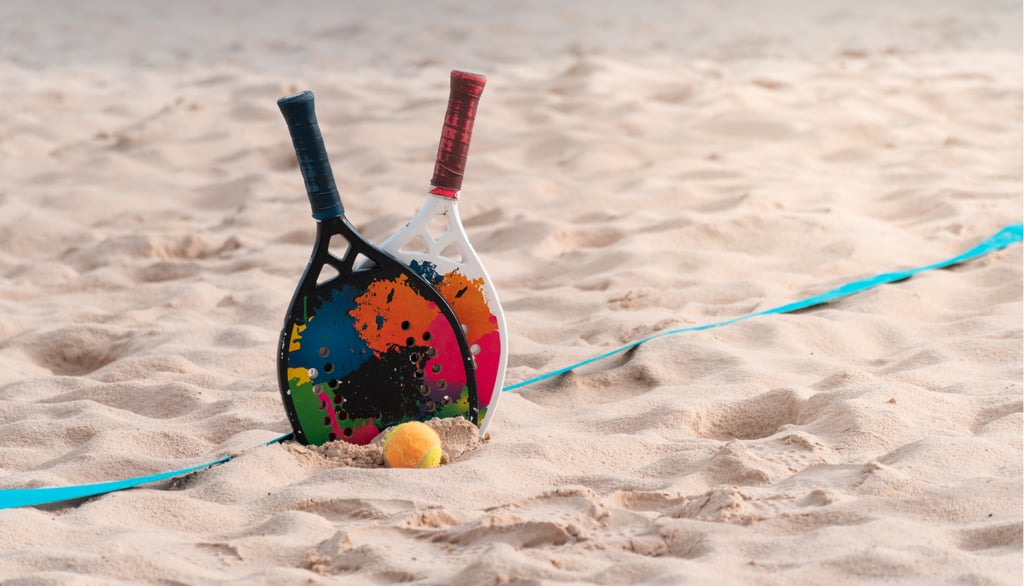Discover beach tennis: the sport that will change your summer and your life!
Discover everything you need in this complete beginner’s guide. Learn about equipment, basic rules, and practical tips to stand out on the sand courts. Click and start playing today!
8/28/20254 min read


If you’ve ever watched a beach tennis court at the beach or your club and thought, “I want to try that!”, this guide is for you. Beach tennis has become a global sensation, combining the fun of the beach, the competitiveness of tennis, and the agility of beach volleyball. It’s a democratic and fun sport that benefits both body and mind.
But how do you start? What should you know before your first swing? This article will guide you from the basics to advanced tips, from choosing your first racket to improving your game. Get ready to fall in love with this sport!
What is beach tennis? A perfect mix of sun, sand, and rackets
As the name suggests, beach tennis is played on sand. It originated in Italy in the 1980s and has since gained worldwide popularity. The court is the same size as a beach volleyball court—16 meters long by 8 meters wide—divided by a net 1.70 meters high.
The goal is simple: hit the ball over the net and make it land in your opponent’s court. The key rule that differentiates it from traditional tennis is that the ball cannot touch the sand before being hit.
Why is it so popular? It requires agility but not extreme strength. It’s easy to learn but challenging to master. And above all, the positive energy on sand courts is contagious.
Ready to dive in? Let’s explore every detail!
Essential Equipment: You Don’t Need Much
One of the biggest advantages of beach tennis is that the initial investment is relatively low. You only need two essential items, plus comfortable clothing.
1. The beach tennis racket
Differences from traditional tennis rackets: Smaller, stringless, made of materials like carbon fiber, fiberglass, or Kevlar, with holes to reduce air resistance.
Weight: For beginners, a lighter racket (320–340g) is ideal, offering more control and reducing injury risk.
Material: Fiberglass rackets are flexible and great for beginners, generating power with less effort. Carbon fiber rackets are stiffer and better suited for experienced players.
Balance: Rackets with weight at the head offer more power; those with weight at the handle are more maneuverable. A balanced racket is ideal for beginners.
2. The beach tennis ball
The ball is also crucial. The International Tennis Federation (ITF) approves Stage 2 balls, which are pressureless tennis balls. They are 50% slower than regular tennis balls, perfect for the pace of sand play, making rallies easier.
Interested in finding your perfect racket? Check our complete guide for choosing the best beginner racket!
Basic rules: easy to learn, fun to play
Beach tennis rules are simpler than you might think. Here’s a quick summary:
Serve: Underhand serve; only one chance to hit the ball over the net.
Scoring: Similar to tennis: 0, 15, 30, 40, Game. At deuce (40/40), a ‘no-ad’ rule applies—the next point wins the game.
Net Touch: Hitting the net with the racket or body during a point is a fault and gives the point to the opponent.
The simplicity of the rules makes it accessible to anyone, of any age. The focus is on fun and enjoyment.
Want to improve beyond the basics? Explore our beach tennis courses to take your skills to the next level.
Beginner tips: do’s and don’ts
Do:
Positioning: Stay near the net, always ready for the next shot.
Grip: Use a continental or “hammer” grip—hold the racket as if it were a hammer.
Shots:
Forehand: Hit the ball with your palm facing forward.
Backhand: Hit with the back of your hand forward; beginners may use two hands.
Smash: Powerful overhead shot for points and spectacle.
Communication: Beach tennis is doubles. Talk to your partner about serves and ball placement.
Don’t:
Worry about a perfect serve—just get the ball over the net.
Use too much force—focus on control; power comes with practice.
Get frustrated—sand can be unpredictable. Mistakes are part of the fun.
Benefits for body and mind: more than just a sport
Beach tennis is not only fun—it’s excellent physical exercise:
Cardiovascular Health: Constant movement on sand elevates heart rate.
Muscle Strength: Sand requires more effort than hard courts, engaging legs, glutes, and core.
Agility & Coordination: Quick reactions are essential on sand.
Socialization: Doubles games foster connection and conversation.
Stress Reduction: Being outdoors and active helps release tension.
Ready to experience all these benefits? Find a court near you and start playing today!
Beach tennis in brazil: a national passion
Brazil is now one of the world’s beach tennis powerhouses. Favorable weather and Brazilians’ love for beach sports fueled rapid growth. Courts have multiplied in clubs and public parks, and the community has expanded tremendously.
In coastal cities like Rio de Janeiro, Florianópolis, or Santos, you’ll find hundreds of courts and instructors ready to welcome you. Even in cities without beaches, training centers with artificial sand courts have become popular.
Grab your racket and hit the court!
Beach tennis is more than a sport; it’s a community, a way to exercise, socialize, and have fun. It’s easy to start, quick to learn, and immensely enjoyable.
If you’ve read this far, your curiosity has likely turned into a desire to play. What are you waiting for? Grab a partner or group of friends, borrow a racket, rent a court, and dive into this adventure. The sand, sun, and fun are waiting for you!
Health
Tips for a healthy and balanced life.
© 2025. All rights reserved.
Well-being
Privacy Policy
Terms and conditions
